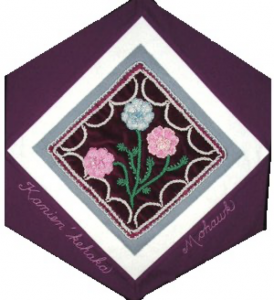Mohawk

The Block
Barbara Little Bear embedded traditional Mohawk symbolism into this block using her own distinct style and a variety of beading techniques to create a partially raised design. Raised beadwork is a distinctly Iroquoian technique that originated with the Mohawk, and the balanced floral pattern is typical of Eastern Woodlands design.
Each part of the design represents something specific. Beaded on a deep purple velvet background, the colour of wampum, flowers with seven petals (for the days of the week) are two-tone pink (females), and blue and white (males); spiral beading forming the strong stems (the men) with many leaves (the women) and sprouting buds (children) represent the community. Twelve domes creating a scalloped inward-facing border surround them; these are the months of the year, as well as the trinities of Earth, Moon, Sun; Fire, Water, Air; the sacred Three Sisters and the family clans. A narrow purple satin band is sandwiched between a beaded white rope and an outer border of delicate ‘pierce-work’ beading, which resembles a blanket stitch, symbolic of the men protecting their village.
Cultural Profile
The Mohawk Nation is known in the Iroquoian dialects as Kanien’Kehaka, meaning “People of the Flint. One of the original Five Nations to join the Haudenosaunee Confederacy (also known as the Iroquois Confederacy), they are referred to as the Elder Brothers. Being the easternmost members of the League, they are also known as the “Keepers of the Eastern Door” and thus use the symbol of the shield. On the Aiionwatha (Hiawatha) wampum belt that represents the Confederacy, the Mohawk take their place on the eastern square next to shards of flint.
The number three is a very meaningful number, interwoven throughout Mohawk culture. There are three clans, the Wolves, Bears and Turtles. Agriculture provided the three mainstays of their diet, corn, beans and squash. These plants, called the Three Sisters, were highly revered. The various stages of the growing seasons were often connected to traditional celebrations and rites. Strawberries were also a sacred and favourite food of the Mohawks. The strawberry, due to its shape and colour, was believed to come from the heart of Mother Earth. In their matrilineal society, it is representative of a strong and spiritual female power that resonates in the heart of every woman. Strawberry juice is often an essential part of traditional Mohawk ceremonies.
Men of the Mohawk typically wore a gustoweh (hat), distinguishable from other Iroquoian hats by its three upright feathers. When Scottish immigrants began to set up stakes in Mohawk traditional territory, the Mohawk adopted some Scottish cultural influences. To this day Mohawk traditional dress often includes a beaded solid–coloured kilt worn by men, while married women sometimes sport a ‘Glengarry’ style hat, also heavily beaded.
The 20,000 plus strong Mohawk Nation, descendents of a proud and resourceful Woodlands people, strongly believe in keeping their culture and traditions alive. They do so even as they adapt to ever-changing times at Akwesasne, Kanesatakeand Kahnawake, modern communities that border the St. Lawrence and Ottawa Rivers and lie across provincial and international borders.
Sponsor: Fraser Family, in memoriam Mary Ann (McDonald) and Eugene Archibald Fraser
